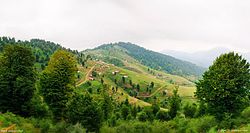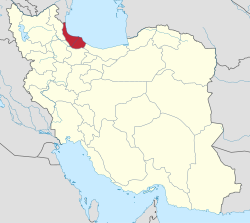Talesh County
Talesh County
Persian: شهرستان تالش | |
|---|---|
 Talesh County mountain landscape | |
 Location of Talesh County in Gilan province (top, green) | |
 Location of Gilan province in Iran | |
| Coordinates: 37°55′15″N 48°47′35″E / 37.92083°N 48.79306°E[1] | |
| Country | Iran |
| Province | Gilan |
| Capital | Tālesh |
| Districts | Central, Asalem, Haviq, Kargan Rud |
| Population (2016)[2] | |
| • Total | 200,649 |
| Time zone | UTC+3:30 (IRST) |
Talesh County (Persian: شهرستان تالش)[a] is in Gilan province, in northwestern Iran. Its capital is the city of Tālesh (also known as Hashtpar).[3]
History
[edit]The Talysh peoples are, as archaeological studies show, one of the oldest inhabitants of the western littoral Caspian Sea areas, which stretches from Dagestan in the north, to Iran in the south. The Talysh have lived in what are known as "Talysh land" for millennia,[citation needed] and are amongst the native inhabitants of what is today Iran and neighboring Azerbaijan. There is a belief amongst scholars, [citation needed] as well as by the Talysh themselves who generally identify with the Cadusii,[4] that the ancient Cadusii are the ancestor of the today's Talysh.
The lands of the Talesh were much larger than the present day area. In olden times the geographical areas of the Talysh people was more than 10,000 km2. [citation needed] At present the Taleshan live in Gilan Province, and some cities in Ardabil Province (Iran) and southeastern Azarbaijan.
The territory of Talesh County was a part of the Karganrud Khanate. After the Russo-Persian War, in order to weaken the influence of Mir Mostafa Khan, Fath 'Ali Shah divided the region among 5 local families, creating the Khamsa of Talesh.[5][6]

Historical monuments and natural sites
[edit]- Salsal village which goes back to Ismaeilieh era near Ghalehbin village located 15 km. from Talesh..
- White Mosque which dates from Seljukian era that situated at Hashtpar (Talesh) city .
- Agh-ev-lar region at a distance of 32 km of this city which is considered among the first grade tourist sites of the Iran.
- Asalem - Khalkhal road, and Laezeh countryside on the way to Khalkhal .
- Coasts of Kissom
- Loomer Waterfall
- Nasrollah Khan Sardar Amjad (Amidossaltaneh) Winter Quarters Castle - dates back to Qajar Era. It has eight sides.
- Nasrolah Khan Sardar Amjad (Amidossaltaneh) Summer Quarters Castle - in Aq Evlar Village.
- Three - Floor Tombs Around the Lighthouse (Atashkadeh), and Remnants of Mard Ali Bil.
- Aq Evlar Old Bath - located in a garden of Merian Village, built in Safavid Era ( 500 years ago).
- Soobatan countryside.
- Talesh Natural Park - covering an area of 80 acres (320,000 m2).

Demographics
[edit]Languages
[edit]Generally speaking, the land of Talesh has been divided in three regions: Gaskarat (Masalli, Taskoh, Shanderman, Rezvashar, Hashtpar, Asalem, Astara); Foumanat (Fouman, Masoleh, and Shaft); and Azerbaijan Taloshian (Lankaran amongst others).[citation needed] In Gaskarat, the majority of people speak Taleshi and Farsi. In Foumanat, most speak Taleshi. Lastly, Talysh from neighboring Azerbaijan are often bilingual and trilingual, consisting of Taleshi, Azeri and Russian speakers.[7]
Gilaki and Taleshi are rapidly losing ground in many cities of Tavalesh due to heavy immigration of people from Azerbaijan.[8]
Ethnicities
[edit]Sir Arnold Wilson wrote:
- "Iran's primary inhabitants generations still in Gilan in the forest areas near a sea (Caspian sea) could be found, these people by Aryan desert settled people expelled from their fatherland and this started 2000 years before Christ and lasted for centuries Sir Arnold Wilson was talking about Taleshian. Land of old Aran which from past till now was the house of Taleshan, was in fact the place that Aryans migration started from many researchers know Kadousian or the ancestors of Taleshian as the old natives of present Iran before the Aryan immigration. Present Taleshian beside other Iranians have a sense of proud of being Iranian and Aryan and are one of the little Iranian communities that kept their pure and Aryan culture."[citation needed]
Religion
[edit]Talesh people at present are Sunni and Shia Muslims. Most of the southern and central Taleshian are Shia, and northern Taleshian are composed of both Shia and Sunni.
Population
[edit]At the time of the 2006 National Census, the county's population was 179,499 in 42,949 households.[9] The following census in 2011 counted 189,933 people in 52,989 households.[10] The 2016 census measured the population of the county as 200,649 in 61,055 households.[2]
Administrative divisions
[edit]Talesh County's population history and administrative structure over three consecutive censuses are shown in the following table.
| Administrative Divisions | 2006[9] | 2011[10] | 2016[2] |
|---|---|---|---|
| Central District | 85,258 | 91,978 | 97,982 |
| Kuhestani-ye Talesh RD | 6,479 | 5,914 | 7,482 |
| Saheli-ye Jokandan RD | 18,232 | 18,515 | 19,442 |
| Tula Rud RD | 19,061 | 15,205 | 16,880 |
| Tālesh (city) | 41,486 | 52,344 | 54,178 |
| Asalem District | 39,089 | 40,569 | 42,219 |
| Asalem RD | 20,226 | 16,117 | 16,442 |
| Khaleh Sara RD | 6,930 | 7,495 | 7,702 |
| Kharajgil RD | 8,586 | 6,917 | 7,355 |
| Asalem (city) | 3,347 | 10,040 | 10,720 |
| Haviq District | 30,348 | 31,840 | 33,940 |
| Chubar RD | 16,429 | 12,877 | 14,299 |
| Haviq RD | 11,201 | 9,247 | 9,826 |
| Chubar (city) | 1,481 | 5,522 | 5,554 |
| Haviq (city) | 1,237 | 4,194 | 4,261 |
| Kargan Rud District | 24,804 | 25,546 | 26,508 |
| Khotbeh Sara RD | 13,495 | 14,036 | 14,291 |
| Lisar RD | 8,710 | 8,248 | 8,570 |
| Lisar (city) | 2,599 | 3,262 | 3,647 |
| Total | 179,499 | 189,933 | 200,649 |
| RD = Rural District | |||
Agriculture
[edit]Rice has been cultivated in this region for many years, where some indigenous cultivars (landrace) were conventionally bred by farmers.[11]
Geography
[edit]Talesh is located on the southwestern coast of the Caspian Sea. Talesh County, covering an area of 2373 square kilometers, is ¼ of surface area of Gilan Province.
Talesh County has inland scenic areas in the Alborz mountain range, with intact natural habitats that are places for appreciating nature.
See also
[edit]![]() Media related to Talesh County at Wikimedia Commons
Media related to Talesh County at Wikimedia Commons
Notes
[edit]- ^ Also known as Tavalesh (طوالش)
References
[edit]- ^ OpenStreetMap contributors (10 October 2023). "Talesh County" (Map). OpenStreetMap (in Persian). Retrieved 10 October 2023.
- ^ a b c "Census of the Islamic Republic of Iran, 1395 (2016)". AMAR (in Persian). The Statistical Center of Iran. p. 01. Archived from the original (Excel) on 4 December 2020. Retrieved 19 December 2022.
- ^ Habibi, Hassan (21 June 1369). "Approval of the organization and chain of citizenship of the elements and units of the national divisions of Gilan province centered on the city of Rasht". Islamic Parliament Research Center (in Persian). Ministry of Interior, Defense Political Commission of the Government Board. Archived from the original on 12 October 2016. Retrieved 12 December 2023.
- ^ Livy, Ab urbe condita, xxxv. 48 Archived 2003-03-09 at the Wayback Machine; Polybius, Histories, v. 79; Historia Augusta: "Caracalla", 6; ibid., Historia Augusta: "The Two Valerians", 2.
- ^ Asatrian, Garnik; Borjian, Habib (2005). "Talish and the Talishis (The State of Research)". Iran & the Caucasus. 9 (1): 45. ISSN 1609-8498.
- ^ Rabino, H. L. (1920). "Rulers of Gilan: Rulers of Gaskar, Tul and Naw, Persian Talish, Tulam, Shaft, Rasht, Kuhdum, Kuchisfahan, Daylaman, Ranikuh, and Ashkawar, in Gilan, Persia". The Journal of the Royal Asiatic Society of Great Britain and Ireland (3): 280–282. ISSN 0035-869X.
- ^ Asatrian, G. and H. Borjian, 2005. Talish: people and language: The state of research. Iran and the Caucasus 9/1, p 43-72
- ^ Gilan. — X. Languages (author Donald Stilo), pp. 660. // Encyclopaedia Iranica. Volume X: Fisheries — Gindaros. Fascicle 6. Edited by Ehsan Yarshater. New York: Bibliotheca Persica Press, 2001, 672 pages. ISBN 0-933273-56-8
... In Gīlān there are three major Iranian language groups, namely Gīlakī, Rūdbārī, and Ṭālešī, and pockets of two other groups, Tātī and Kurdish. The non-Iranian languages include Azeri Turkish and some speakers of Gypsy (Romany, of Indic origin). Gīlakī is spoken by possibly three million people as a first or second language, and has had a budding literature and fledgling prose publications, including newspapers, but both Gīlakī and Ṭālešī are rapidly losing ground in many cities of Tavāleš due to heavy immigration of people from Azerbaijan. ...
- ^ a b "Census of the Islamic Republic of Iran, 1385 (2006)". AMAR (in Persian). The Statistical Center of Iran. p. 01. Archived from the original (Excel) on 20 September 2011. Retrieved 25 September 2022.
- ^ a b "Census of the Islamic Republic of Iran, 1390 (2011)". Syracuse University (in Persian). The Statistical Center of Iran. p. 01. Archived from the original (Excel) on 8 October 2023. Retrieved 19 December 2022.
- ^ Pazuki, Arman & Sohani, Mehdi (2013). "Phenotypic evaluation of scutellum-derived calluses in 'Indica' rice cultivars" (PDF). Acta Agriculturae Slovenica. 101 (2): 239–247. doi:10.2478/acas-2013-0020. Retrieved 2 February 2014.
External links
[edit]- Gitashenasi.com: Provincial Atlas of Iran — اطلس گیتاشناسی استانهای ایران
- Livius.org: "Cadusians" − by Jona Lendering.

